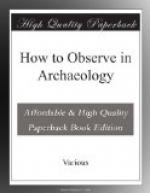Small objects are best laid on black velvet, and taken vertically. Scraps of charcoal are useful to prop them in exact positions. A sheet of white paper stuck on a leg of the stand may be useful to prevent shadows being too heavy. Where outline, and not flat detail, is wanted, then a light ground is best; the most perfect is a sheet of ground glass with white paper a foot or two below it. If the ground glass cannot be had, a good substitute-also useful for a camera glass-is plain glass with a sheet of tissue paper (or the packing paper of films) stuck on with paraffin wax.
The dressing of objects to show up clearly is often needful. Incised objects can be filled in with charcoal powder if light, or chalk if dark; in any case a coarse powder, so as not to stain the object. For faint cutting on glass or crystal go over the lines with ’China ink in a pen, so as to cover them. Harden the ink in the sun, and then gently wipe with a damp finger until all the excess is removed and only the roughness of the lines remains black. On large objects light dust or sand is often useful, to make relief clearer.
For objects in a bad light, or in the interior of tombs, reflected light must be used. Lids of biscuit tins serve well; a lid in the sun sixty feet off, and another lid reflecting the light on to a wall, will suffice for a two minutes’ exposure of a slow plate. Three or four successive reflections into a totally dark chamber will suffice in five or six minutes.
When an important subject cannot be revisited it is well to take duplicates; the camera should be shifted laterally a few inches for a near object, or a few feet for a distant view, and then the two films will form a stereograph, if both succeed.
In arranging groups of small objects, put together what will go in a three-inch circle, and minor pieces around, and then the best in the middle can be printed direct on lantern slides.
7. Preservation and Packing.
While travelling little can be done for preserving objects. Papyrus rolls should be wrapped at once in a damp handkerchief, to be carried, and then wrapped in paper, packed in a tin box, and filled round with cotton wool. Small papyri can be safely damped in a wet cloth, and flattened out between the leaves of a book; secure one edge straight in the hinge, and gradually press flat and secure by advancing leaves over it. Glass, if perfect, should be packed in tins with wool; old food or tobacco tins do well for tender things.
Flint implements and coins, though hardy, should be saved from grinding by wrapping in waste paper.
Ivory, if it has been buried, is very liable to flake. The cure is to soak it in paraffin wax; but temporarily it is secured by winding cotton thread round it in many directions. Some anoint it with vaseline, but if vaseline penetrates the ivory, it will not take up paraffin or gelatine later. Tender wood may be likewise saved.




